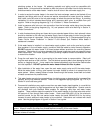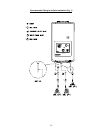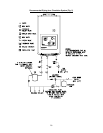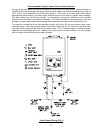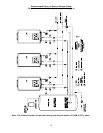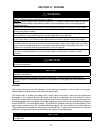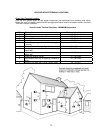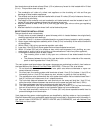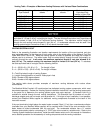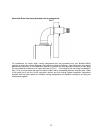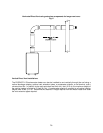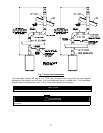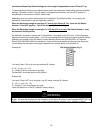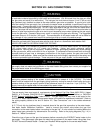
22
Vent terminals must terminate at least 3 feet (0.9 m) above any forced air inlet located within 10 feet
(3.1 m). This provision does not apply to:
1. The combustion air intake of a direct vent appliance or the circulating air inlet and flue gas
discharge of listed outdoor appliances.
2. The exhaust vent terminal must be installed with at least 12 inches (30 cm) of clearance from any
air opening into a building.
3. The bottom of the exhaust vent and combustion air intake terminals must be located at least 12
inches (30 cm) above grade and above the anticipated snow level.
4. Must be installed at least 3 feet (0.9 m) from any gas meter, gas valve or other gas regulating
equipment.
5. Must be installed in a location where it will not be blocked by snow.
EXCEPTIONS FOR INSTALLATIONS
The vent terminal must not terminate:
1. Directly above a paved sidewalk or paved driveway which is located between two single-family
dwellings and serves both dwellings;
2. Less than 7 feet (2.1 m) above a paved sidewalk or a paved driveway located on public property;
3. Above a gas meter/regulator assembly within 3 feet (0.9 m) horizontally of the vertical centerline
of the regulator;
4. Within 6 feet (1.8m) of any gas service regulator vent outlet;
5. Less than 1 foot (30.5 cm) above grade level and the anticipated snow level;
6. Within 12 inches (30.5 cm) of a window or door, which can be opened in any building, any non-
mechanical air supply inlet to any building, or the combustion air inlet of any other appliance;
7. Underneath a veranda, porch or deck, unless:
• The veranda, porch or deck is fully open on a minimum of two sides beneath the floor
and
• The distance between the top of the vent termination and the underside of the veranda,
porch or deck is greater than 1 foot (30.5 cm).
The vent system must terminate so that proper clearances are maintained as cited in local codes or
the latest edition of the
National Fuel Gas Code, ANSI Z223.1.73.4e and 7.8a, b as follows:
1. Do not terminate the exhaust vent terminal over public area where condensate or vapor can
cause nuisance or hazard.
2. For direct vent, the venting system shall terminate at least 1 foot (0.3 m) below, 1 foot (0.3 m)
horizontally from or 1 foot (0.3 m) above any door, window, or gravity air inlet into building.
3. The manufacturer also recommends the vent system terminations not be installed closer than 1
foot (0.3 m) from an inside corner of an L shaped structure.
4. The horizontal distance between two vent terminals on the same wall shall be 1 foot (0.3 m),
while the vertical distance between two terminals on the same wall shall be 5 feet (1.52 m).
5. The distance between two facing vent terminals shall be 4 feet (1.22 m)
6. The vent termination shall not be mounted directly above or within 3 (0.9 m) feet horizontally
from an oil tank vent or gas meter to avoid potential freeze-up from condensation.
7. The vent shall terminate a minimum of 12 inches (30.5 cm) above expected snowfall level to
prevent blockage of vent termination.
Vent pipes serving power vented appliances are classified by building codes as “vent connectors”.
Required clearances from combustible materials must be provided in accordance with information in
this manual under LOCATION OF WATER HEATER and CLEARANCES, and
with National Fuel
Gas Code and local codes.



